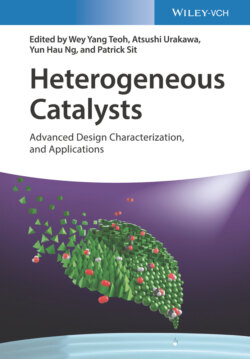Читать книгу Heterogeneous Catalysts - Группа авторов - Страница 83
6.3.2.2 Top‐Down Synthetic Methods
ОглавлениеThe top‐down strategy is based on turning ordered nanostructured into smaller pieces to give desirable properties and intriguing performance [50]. This strategy can also be used to synthesize SACs. A high‐temperature atomic migration method is a typical top‐down synthetic method to obtain SACs.
High temperatures are usually detrimental to catalysts' activities because SAs tend to move and agglomerate due to its high surface free energy. Ostwald ripening is one of the mechanisms to explain this process. The elemental steps of that process typically include the detachment of the metal atoms from smaller particles to form monomers, the diffusion of monomers on supports, and the attachment toward larger particles [64]. Tang and coworkers prepared single‐Ag‐atom catalysts, starting from Ag NPs supported on HMO [65]. Upon heating at 400 °C, the Ag NPs on HMO can be dispersed to form single Ag atoms, as evidenced by in situ transmission electron microscopy (TEM), in situ X‐ray diffraction (XRD), and ex situ X‐ray absorption near edge spectroscopy (XANES) (Figure 6.8) [15, 65–67]. Datye and coworkers showed that at 800 °C in oxidizing ambient, Pt can transfer to ceria and be trapped there to form a sinter‐resistant, atomically dispersed catalyst [68]. Li and coworkers reported the successful reversion of sintering effects and the conversion of noble metal NPs into thermally stable and highly active SAs (Pd, Pt, Au) above 900 °C in an inert atmosphere by using nitrogen‐doped carbon derived from a metal–organic framework [69]. Such a high‐temperature atomic migration method requires a supply of mobile atoms and a support that can bind the mobile species. This method is potentially applicable for synthesizing high‐performance thermally stable SACs and reactivating sintered noble metal nanocatalysts.
Figure 6.8 (A) HAADF‐STEM image of Ag1/HMO. (B) Three‐dimensional projected image of the dash rectangle in (A). (C) The shrinking process of the supported Ag NPs heated by an electron beam. (D) Three‐dimensional and contour maps of in situ differential XRD patterns of AgNP/HMO. (E) Ag K‐edge χ(R) k3‐weighted FT EXAFS spectra of the samples.
Source: Adapted from Chen et al. 2015 [66] and Chen et al. 2016 [15].
(See online version for color figure).
